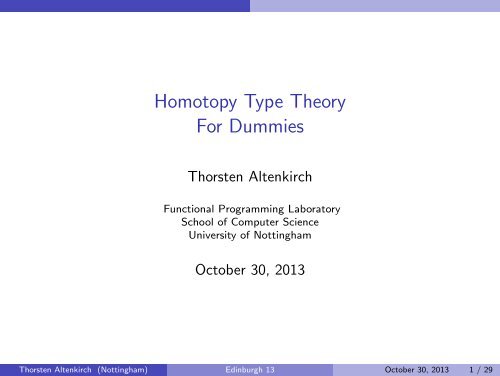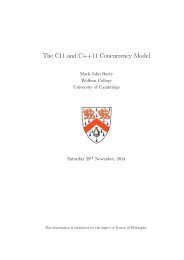Homotopy Type Theory For Dummies
1ER2Xug
1ER2Xug
- No tags were found...
You also want an ePaper? Increase the reach of your titles
YUMPU automatically turns print PDFs into web optimized ePapers that Google loves.
<strong>Homotopy</strong> <strong>Type</strong> <strong>Theory</strong><br />
<strong>For</strong> <strong>Dummies</strong><br />
Thorsten Altenkirch<br />
Functional Programming Laboratory<br />
School of Computer Science<br />
University of Nottingham<br />
October 30, 2013<br />
Thorsten Altenkirch (Nottingham) Edinburgh 13 October 30, 2013 1 / 29
Intro<br />
The HoTT book<br />
Outcome of the Special<br />
Year on <strong>Homotopy</strong> <strong>Type</strong><br />
<strong>Theory</strong> at Princeton.<br />
Proposes an extension of<br />
Martin-Löf <strong>Type</strong> <strong>Theory</strong><br />
as a new foundation of<br />
Mathematics.<br />
Informal use of <strong>Type</strong><br />
<strong>Theory</strong> to appeal to<br />
Mathematicians (but not<br />
only).<br />
Additional principles<br />
inspired by <strong>Homotopy</strong><br />
<strong>Theory</strong>.<br />
Thorsten Altenkirch (Nottingham) Edinburgh 13 October 30, 2013 2 / 29
Basic <strong>Type</strong> <strong>Theory</strong><br />
<strong>Type</strong> <strong>Theory</strong> 101<br />
Martin-Löf <strong>Type</strong> <strong>Theory</strong>: foundational system for<br />
constructive Mathematics<br />
Based on Curry-Howard equivalence<br />
proofs : proposition = programs : type<br />
E.g. as we recursively define the function (+) : N → N → N:<br />
0 + n :≡ n<br />
S(m) + n :≡ S(m + n)<br />
we recursively define the proof:<br />
assoc : Π i,j,k:N (i + j) + k = i + (j + k)<br />
assoc(0, j, k) :≡ refl(j + k)<br />
assoc(S(i), j, k) :≡ ap(S, assoc(i, j, k))<br />
Theorem proving becomes functional programming!<br />
Basis of a number of proofs assistants / programming languages :<br />
NuPRL, LEGO, Coq, Agda, Idris, . . .<br />
Thorsten Altenkirch (Nottingham) Edinburgh 13 October 30, 2013 3 / 29
Basic <strong>Type</strong> <strong>Theory</strong><br />
Proof-relevant mathematics<br />
The axiom of choice (AC ∞ ) in <strong>Type</strong> <strong>Theory</strong><br />
(given A, B : <strong>Type</strong>, R : A → B → <strong>Type</strong>):<br />
(Πa : A.Σb : B.R(a, b)) → (Σf : A → B.Πa : A.R(a, f (a)))<br />
AC ∞ is provable, the proof is given by<br />
ac f = (λa.fst(f (a)), λa.snd(f (a))<br />
where fst,snd are the projections associated with Σ.<br />
Proofs in <strong>Type</strong> <strong>Theory</strong> can contain information.<br />
We call a type A propositional (A : Prop), if it contains no<br />
information.<br />
A propositional version of the axiom AC −1 is not provable and<br />
implies excluded middle.<br />
Thorsten Altenkirch (Nottingham) Edinburgh 13 October 30, 2013 4 / 29
Identity types<br />
Identity types<br />
Given A : <strong>Type</strong> and a, b : A we can form<br />
a = A b : <strong>Type</strong><br />
the type of proofs that a is equal to b.<br />
The canonical inhabitant is<br />
refl(a) : a = A a<br />
given a : A.<br />
The eliminator for equality types is<br />
J(a) : Π P:Πb:A.a=b→<strong>Type</strong> P(a, refl(a)) → Π x:A,α:a=x P(x, α)<br />
for a : A, with the definitional equality J(P, p, refl(a)) ≡ p.<br />
Thorsten Altenkirch (Nottingham) Edinburgh 13 October 30, 2013 5 / 29
Identity types<br />
Groupoid structure<br />
Using the non-dependent version of J<br />
transport : Π a,b:A Π P:A→<strong>Type</strong> a = b → P(a) → P(b)<br />
we can show that = is an equivalence relation:<br />
α −1 : b = a<br />
for α : a = b<br />
α; β : a = c for α : a = b, β : b = c<br />
Using J we can also show:<br />
α, refl = α<br />
refl; α = α<br />
(α; β); γ = α; (β; γ)<br />
α; α −1 = refl<br />
α −1 ; α = refl<br />
That is = forms a groupoid.<br />
Thorsten Altenkirch (Nottingham) Edinburgh 13 October 30, 2013 6 / 29
Identity types<br />
Should equality be propositional?<br />
Should equality be propositional ? I.e. can we prove Uniqueness of<br />
equality proofs (UIP):<br />
Using J this is can be reduced to:<br />
Π a,b:A Π p,q:a=b q = p<br />
Π a:A Π p:a=a p = refl<br />
Hofmann and Streicher showed that UIP cannot be derrived from J<br />
using a groupoid model of <strong>Type</strong> <strong>Theory</strong>.<br />
More recently, Voevodsky observed that UIP is also refuted by a<br />
homotopy model of <strong>Type</strong> <strong>Theory</strong>.<br />
Basic idea:<br />
<strong>Type</strong>s topological spaces<br />
a : A points in the space<br />
a = A b paths between the points<br />
Thorsten Altenkirch (Nottingham) Edinburgh 13 October 30, 2013 7 / 29
Homotopic interpretation<br />
Homotopic Model<br />
A : <strong>Type</strong><br />
a, b : A<br />
p, q : a = b<br />
H : p = q<br />
Thorsten Altenkirch (Nottingham) Edinburgh 13 October 30, 2013 8 / 29
Homotopic interpretation<br />
Uniqueness of Identity proofs ?<br />
Π p:a=a p = refl ?<br />
Thorsten Altenkirch (Nottingham) Edinburgh 13 October 30, 2013 9 / 29
Homotopic interpretation<br />
Uniqueness of Identity proofs ?<br />
Okay, but what now?<br />
Thorsten Altenkirch (Nottingham) Edinburgh 13 October 30, 2013 10 / 29
Homotopic interpretation<br />
While we cannot show UIP<br />
We can show:<br />
Π p:a=a p = refl(a)<br />
Π p:a=a (a, p) = Σx:A x=a (a, refl(a))<br />
This follows from SCTR (singletons are contractible):<br />
assuming a : A.<br />
On the other hand<br />
Π (b,p):Σb:A,a=b (a, refl(a)) = (b, p)<br />
J(a) : Π P:Πb:A.a=b→<strong>Type</strong> P(a, refl(a)) → Π x:A,α:a=x P(x, α)<br />
can be derived from transport<br />
and SCTR.<br />
transport : Π a,b:A Π P:A→<strong>Type</strong> a = b → P(a) → P(b)<br />
Thorsten Altenkirch (Nottingham) Edinburgh 13 October 30, 2013 11 / 29
Homotopic interpretation<br />
J in the <strong>Homotopy</strong> interpretation<br />
To show<br />
Π p:a=a (a, p) = Σx:A x=a (a, refl(a))<br />
we use<br />
Π (b,p):Σb:A,a=b (a, refl(a)) = (b, p)<br />
Thorsten Altenkirch (Nottingham) Edinburgh 13 October 30, 2013 12 / 29
The univalence axiom<br />
Univalence<br />
Rejection of UIP is not the only thing the <strong>Homotopy</strong> interpretation is<br />
good for.<br />
It also suggests an additional principle: the univalence axiom.<br />
This axiom can also be justified from a purely logical perspective.<br />
And it is inconsistent with UIP!<br />
Thorsten Altenkirch (Nottingham) Edinburgh 13 October 30, 2013 13 / 29
The univalence axiom<br />
What is equality of functions ?<br />
Given f , g : A → B we define extensional equality :<br />
f ∼ g :≡ Π a:A f (a) = g(a)<br />
We can show<br />
app : f = g → f ∼ g<br />
Extensionality corresponds to requiring app to be an isomorphism.<br />
It’s inverse is functional extensionality.<br />
This can be justified by the black box view of functions.<br />
Thorsten Altenkirch (Nottingham) Edinburgh 13 October 30, 2013 14 / 29
The univalence axiom<br />
What is the equality of types?<br />
Given A, B : <strong>Type</strong> we define isomorphism A ∼ B as<br />
f : A → B<br />
g : B → A<br />
η : Π a:A a = g(f (a))<br />
ɛ : Π b:B b = f (g(b))<br />
In the absence of UIP we can require coherence properties which<br />
correspond to the triangle equalities of an adjunction:<br />
δ : Π a:A ap(f , η(a)) = ɛ(f (b))<br />
δ ′ : Π b:B η(g(b)) = ap(g, ɛ(n))<br />
where ap(f ) : Π a,a ′ :Aa = a ′ → f (a) = f (a ′ )<br />
We can derive δ from δ ′ and vice versa, because equality is a groupoid.<br />
We define equivalence A ≈ B as given by isomorphism and δ.<br />
Thorsten Altenkirch (Nottingham) Edinburgh 13 October 30, 2013 15 / 29
The univalence axiom<br />
What is the equality of types?<br />
We can show:<br />
coe : A = B → A ≈ B<br />
The univalence axiom sates that coe is an equivalence.<br />
This is justified by a black box view of types.<br />
Note that the univalence axiom implies functional extensionality.<br />
Thorsten Altenkirch (Nottingham) Edinburgh 13 October 30, 2013 16 / 29
Truncation levels<br />
Truncation levels<br />
In the absence of UIP we classify types according to the complexity of<br />
their equality types.<br />
We say a type A : <strong>Type</strong> is contractible or a -2-type, if<br />
is inhabited.<br />
Σ a:A Π x:A x = a<br />
A type A : <strong>Type</strong> is a n + 1-type, if all its equality types a = A a ′ for<br />
a, a ′ : A an n-types.<br />
To show that any n-<strong>Type</strong> is also a n + 1-type we need to show that if<br />
a type is contractible, then its equalities are contractible too.<br />
Thorsten Altenkirch (Nottingham) Edinburgh 13 October 30, 2013 17 / 29
Truncation levels<br />
A contractible → a = A a ′ contractible<br />
Assume that A is contractible, that means we have<br />
a 0 : A<br />
h : Π x:A x = a 0<br />
Now for any a, a ′ : A we have<br />
α 0 (a, a ′ ) : a = a ′<br />
α 0 (a, a ′ ) :≡ h(a); h(a ′ ) −1<br />
We need to show that<br />
Π a,a ′ :AΠ p:a=a ′p = α 0 (a, a ′ )<br />
Using J it is sufficient to show<br />
Π a:A refl(a) = α(a, a) ≡ h(a); h(a) −1<br />
Which is just one of the groupoid laws.<br />
Thorsten Altenkirch (Nottingham) Edinburgh 13 October 30, 2013 18 / 29
Truncation levels<br />
The Truncation Hierarchy<br />
level<br />
-2 contractible types<br />
-1 propositions The theorem we just proved<br />
implies that it is enough that<br />
Π a,a ′ :Aa = a ′ .<br />
0 sets UIP corresponds to the assumption<br />
that every type is a<br />
set.<br />
1 groupoids<br />
.<br />
.<br />
Thorsten Altenkirch (Nottingham) Edinburgh 13 October 30, 2013 19 / 29
Truncation levels<br />
Higher types<br />
How do we get types at higher levels?<br />
The 1st universe <strong>Type</strong> 0 cannot be a set.<br />
Consider Bool = Bool, using univalence there are two equivalences:<br />
id, and negation.<br />
However, id and negation cannot be equal.<br />
My student Nicolai Kraus proved that the nth universe is an cannot<br />
be an n-type.<br />
Thorsten Altenkirch (Nottingham) Edinburgh 13 October 30, 2013 20 / 29
HITs<br />
Higher inductive types<br />
There are other ways to obtain higher types in HoTT.<br />
A higher inductive type has not only constructors for elements but<br />
also for equalities.<br />
A simple example is S 1 : <strong>Type</strong><br />
base : S 1<br />
loop : base = base<br />
S 1 homotopically behaves like the circle.<br />
Indeed we can embedd i : Z into φ(i) : base = base:<br />
i<br />
↦→loop n<br />
0 ↦→refl<br />
− n<br />
↦→(loop −1 ) n<br />
Thorsten Altenkirch (Nottingham) Edinburgh 13 October 30, 2013 21 / 29
HITs<br />
Higher inductive types<br />
S 1 also comes with eliminators: just consider the non-dependent<br />
eliminator:<br />
satisfying the equalities<br />
Elim S1 : Π M:<strong>Type</strong> Π b:M (b = b) → S 1 → M<br />
Elim S1 (M, b, q, base) ≡ b<br />
ap(Elim S1 (M, b, q), loop) ≡ q<br />
Using univalence we can prove α : Z = Z using the equivalence<br />
(λn.n + 1, λn.n − 1, . . . ).<br />
We define a family:<br />
F : S 1 → <strong>Type</strong><br />
F = Elim S1 (<strong>Type</strong>, Z, α)<br />
Thorsten Altenkirch (Nottingham) Edinburgh 13 October 30, 2013 22 / 29
HITs<br />
Higher inductive types<br />
This allows us to define an inverse to φ: Given p : base = base we<br />
can construct<br />
transport(F , p)<br />
: F (base) → F (base)<br />
Note that F (base) ≡ Z. Hence we define:<br />
φ −1 (p) :≡ transport(F , p, 0) : Z<br />
Dan Licata showed how we can use the dependent eliminator to<br />
derive that φ, φ −1 are inverse and hence:<br />
(base = base) = Z<br />
Thorsten Altenkirch (Nottingham) Edinburgh 13 October 30, 2013 23 / 29
HITs<br />
The sphere<br />
The circle S 1 is 1-type (groupoid), all higher equalities are<br />
propositional.<br />
However, the situation is different for the sphere S 2 : <strong>Type</strong> which can<br />
be defined as a HIT:<br />
base : S 2<br />
loop : refl(base) = refl(base)<br />
None of the higher equalities of S 2 are propositional.<br />
Hence S 2 has no finite truncation level.<br />
Thorsten Altenkirch (Nottingham) Edinburgh 13 October 30, 2013 24 / 29
HITs<br />
Truncations<br />
We can use HITs to define truncations, which is the adjoint to the<br />
embedding.<br />
E.g. given A : <strong>Type</strong> the -1-truncation ||A|| −1 : <strong>Type</strong> (also called<br />
bracket types, squash types) is given by<br />
Clearly, ||A|| −1 : Prop and<br />
for P : Prop.<br />
We can use this to define AC −1 :<br />
η : A → ||A|| −1<br />
uip : Π a,a ′ :||A|| −1<br />
a = a ′<br />
A → P = ||A|| −1 → P<br />
(Πa : A.||Σb : B.R(a, b)|| −1 ) → (||Σf : A → B.Πa : A.R(a, f (a))|| −1 )<br />
AC −1 implies excluded middle for Prop, i.e. P + ¬P for P : Prop<br />
(Diaconescu’s construction).<br />
We can generalize this to arbitrary levels ||A|| n is an n-type.<br />
Thorsten Altenkirch (Nottingham) Edinburgh 13 October 30, 2013 25 / 29
Metatheory<br />
Canonicity<br />
We have introduced additional constants proving equalities:<br />
◮ functional extensionality<br />
◮ univalence<br />
◮ equality constructors for HITs<br />
While we have introduced some definitional equality, they are<br />
insufficient to guarantuee canonicity:<br />
All closed terms of type N are definitionally equal (indeed reducible)<br />
to a numeral.<br />
While we (with Conor McBride and Wouter Swierstra) have developed<br />
an approach to solve the problem for functional extensionality<br />
(Observational <strong>Type</strong> <strong>Theory</strong>), this relies on a strong form of UIP.<br />
Thorsten Altenkirch (Nottingham) Edinburgh 13 October 30, 2013 26 / 29
Metatheory<br />
Constructive models<br />
The homotopy interpretation of type theory uses Kan Fibrations in<br />
simplicial sets (the simplicial set model).<br />
This construction relies essentially on classical principles.<br />
Thierry Coquand has suggested a modification of this construction<br />
using semi-simplicial sets.<br />
This models only weak <strong>Type</strong> <strong>Theory</strong> (i.e. no conversion under λ).<br />
An alternative would be to directly use weak ω-groupoids.<br />
It seems likely that an answer to this question would also provide a<br />
solution to the canonicity problem.<br />
Thorsten Altenkirch (Nottingham) Edinburgh 13 October 30, 2013 27 / 29
Computer Science ?<br />
Why should we care?<br />
Structures can be 1st class citizens.<br />
(equality is isomorphism)<br />
HITs provide better ways to define the Cauchy Reals and the<br />
constructible hierarchy (avoiding choice).<br />
Quotient containers (like multisets) become ordinary containers.<br />
Thorsten Altenkirch (Nottingham) Edinburgh 13 October 30, 2013 28 / 29
Computer Science ?<br />
The HoTT people<br />
Thorsten Altenkirch (Nottingham) Edinburgh 13 October 30, 2013 29 / 29





